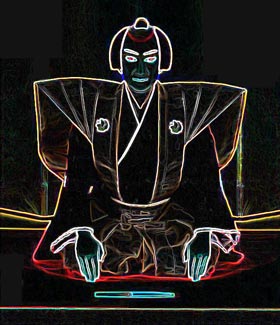| Comments |
4th edition of the Naniwa Hanagata Kabuki April program, staged by a troupe of young Kamigata actors.
Tengajaya: "Tengajaya"
was first performed in 1781 in ďsaka, dramatizing a
true event that occurred over a century earlier. It is in the classical vengeance
play form, following the sufferings of the brothers Iori (Nakamura Senjaku) and Genjir˘ (Nakamura Kikaku)
as they search for T˘ma (Kataoka Ainosuke), the killer of their father. Iori first falls ill
and then is wounded by the enemy and finally ends up living in a shack as a
beggar where he is killed by the enemy. But the real reason for the continuing
popularity of this is not due to the historical incident, which has long since
been forgotten, nor because it is a vengeance play since there are other,
much more popular vendetta plays. Originally the role of the servant Motoemon (Nakamura Kanjaku),
a retainer of Iori's family who goes over to the enemy side was very small,
but the actor ďtani Tomoemon IV transformed
it into a brilliant, virtuoso role. At first Motoemon is supposed to guard his lord,
but fails due to his weakness for drink. He promises his brother Yasuke (Band˘ Shinsha) to
stop drinking, but is tricked by the enemy into getting dead drunk
and during this time, T˘ma kills his lord. Motoemon is ready to kill himself to
atone, but instead decides to go to the enemy side.
There is no trick he will not stoop to, in order to turn things to his
advantage. For example, Motoemon tells his brother (who is still loyal to Iori)
that he has become blind due to illness, no doubt punishment for his evil arts,
and asks for charity. But in fact, he soon sneaks in, kills his brother
and wounds Iori, all in order to protect his new lord T˘ma. But in the end, Genjir˘
avenges his father's death with the help of former retainers of his father's clan.
Ame no Gor˘: Soga no Gor˘ is one of the most famous heroes in the
Kabuki world, super-strong and quick to fight. However, this dance shows the soft
side of this hero as well as he travels nightly to the pleasure quarter to visit
his lover. Starring Kataoka Shinnosuke as Gor˘.
Kasane: one can never escape past evils. Yoemon is fleeing to the
countryside, but Kasane, the woman he abandoned, refuses to let him go.
She catches up with him at a lonely river bank. A skull stabbed with a
scythe appears and Kasane is possessed by its spirit, actually
the spirit of her dead father, and her face suddenly becomes disfigured.
She pours out her feelings of jealousy and resentment and Yoemon kills Kasane,
but even after her death, he cannot escape her vengeful spirit.
Starring Kataoka Takatar˘ as Kasane and Kataoka Ainosuke as Yoemon.
Sonezaki Shinjű: a young merchant named Hiranoya Tokubŕ has long been in
love with the courtesan Tenmaya Ohatsu and is diligently trying to buy out her contract.
But he is swindled out of his money by someone he considered a friend.
Then he is beaten and humiliated in the precincts of the Ikutama Shrine.
He sneaks into the teahouse where Ohatsu is and she hides him under the veranda.
At this point, Tokubŕ's "friend" comes and calls him a criminal.
Ohatsu fiercely defends Tokubŕ and asks whether he is prepared to defend his
honor by committing love suicide. Silently, from under the veranda,
he holds her bare foot and draws it across his neck. The journey to the forest
where they commit love suicide is like a dream, half-way between this world
and the next and has some of the most famous lines in Japanese theatre:
"Farewell to this world and to this night, farewell. To what should we who go
to our deaths be likened? We are like the frost on the road leading to the
graveyard, vanishing with each step". Starring Nakamura Kanjaku and Nakamura Senjaku in
the roles of Tokubŕ and Ohatsu.
Natsu Matsuri: this grisly murder story became a smashing hit
when it was first performed in 1745 because of the chivalrous spirit of the
many ďsaka characters appearing in this story, the contrast between a brutal murder
and the jovial mood of a summer festival, and the splashing of real water
used on the stage. Danshichi, a gallant fishmonger, does everything he can to protect
the weak young son of his patron with the help of his companion Tokubŕ
and the older Sabu. Although even Tokubŕ's wife Otatsu heroically helps out,
in the end, Danshichi is betrayed by his evil father-in-law Giheiji and,
in the most famous scene of the play, must kill him in a mud-covered fight
in a lonely alley with the shouts of the local festival nearby.
This program stars Kataoka Ainosuke as Danshichi,
with Nakamura Kikaku, Nakamura Kanjaku and Nakamura Senjaku as Issun Tokubŕ, Tsuribune Sabu and Otatsu.
Source: Earphone Guide website
|


